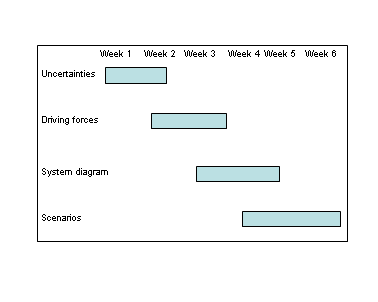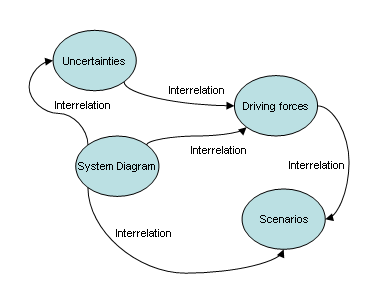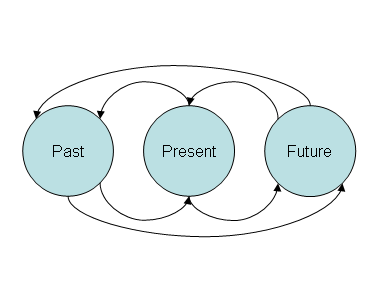Back to the Future
Introduction
Looking from a scope from the beginning to the future I have built up my personal reflection around the topic back to the future. I will describe what I thought the course would be like and thought I was going to learn during the lectures, this will be discussed in the before image. After that I will give a reflection about what I think ICT planning is about and what I have learned during the lectures and workshops.
As a conclusion I want to add an overall course reflection, in which I will write about what I liked about the lectures. I also want to take the chance to discuss the role of the lecturer in the overall learning process during this lecture. Last I would like to discuss the future reflection, how this topic can and possibly will influence my future and a general perspective about the future as I perceive it to be.
Before Image
When thinking of planning, you first of all think of a big schedule with a planning based on for example a Gant chart, with all the activities described and how long it will take to be completed. This is of course a general view of the activities that need to take place, but I would say it is an accurate one.
I was thinking well planning will describe different methodologies how to start planning a project and which aspect you have to consider while planning and setting up a schedule and how to estimate the time an activity will take based on best practices. The first part of the ICT Strategy was mostly about the different approaches towards how to set up a strategy with architectures and how you can approach it, so I thought it would be an edition to ICT strategy.

After Image
After having attended the first lecture of a total of four, I was astonished to find out that my image of the reality was completely wrong. ICT planning has a completely different angle of approach then what I had imagined planning to be.
Planning is more a kind of strategic approach, in which you look at the different scenarios about the world a company resides in and what can happen that will change the world as they know it. This is of course a general description of what planning is.
In the other lectures I was exposed with the challenge to think outside the box and think beyond the limitation of what I perceived the world around me to be. To achieve this I needed not only to enhance my creative thinking but also take advantage of the different lectures that laid out the building blocks to achieve a certain method of thinking.
The systematic approach is a good way of looking beyond the horizon and seeing through the different aspect that are interrelated with each other.

Course reflection
I found the course having a new approach of tackling the issued that are discussed. The time constraint did take out a lot of learning experience we and I could have gained from the lectures, because per lecture we could have spent more time on a certain topic or even cover more topics.
Seeing beyond the time constraint, it is obvious this course has had its impact in the way I perceived the world. Of course I have had some experience in brainstorming and drawing linkages between objects, but this gives a whole new insight on how to approach it in a way that enabled me to think and see much more. Widening the perspective you look at a topic makes it more obvious that you miss a lot of aspects that will help you understand the world you are researching more clearly.
From the start I saw a completely different perspective on how to think strategically and thinking together within a group. Everyone has a different perception on a certain topic and everyone sees importance in a different way. I think that ICT planning is not only being able to think differently, but also to accept input from other and do a research together about a topic; this will enhance your research and give you more insight to create the knowledge base needed to workout good scenarios.
Looking at what I learned from the theory discussed in the lectures, of course it forms a consistent methodology how to create scenarios. Taking the uncertainties and doing research about the topic helped establish a different insight than what I usually was used to, which was taking problems and finding solutions for that. Uncertainties are the more unobvious problems you don’t look at directly, because you don’t take notice of them in the first case in practice.
From the driving forces I have learned two things. First of all it is a specialized way to research a specific part of a topic which influences the general topic, and second it enables to look at what drives a certain industry and what is important to research.
From the uncertainties and the driving forces came the system diagram. Well I learned how difficult it is to make a system diagram; of course a fundamental research should be the bases of a good system diagram. I also learned it is better to think of a topic from zero than to think of a topic you already know from the point you start with it. You see during the creation of the system diagram as we saw that we made a real big diagram, of course it was one big mess, but like I know creativity is not always structured and tidy, its chaos! And I learned of course chaos is good, well at least in this kind of situations.
All these points lead to good scenarios; this last part of the learning process might be considered the most difficult one, although it takes a complete understanding of the information to make good scenarios you also need good insight to make logical and good linkages to make a consistent and convincing story. I understand that a scenario is not just a few segments told in a timeline. It is a complete story in itself, which depicts what will happen in the future and which elements will influence the course the future, will move forward to.
If I look at the work I created and the scenarios we had some good points. I liked the system diagram because we created it from scratch after the first time and added loads more information we found, but I didn’t like the scenarios that we presented that much because it seemed to lack something; it was more a gut feeling than common sense. Overall we did are best to understand the subject and create a concept in a short period of time that I think I learned a lot from.
Lecturer reflection
The lecturer is a knowledgeable person who knows what he’s talking about, but more important than that he knows how to share knowledge with other people. A good lecturer has the ability to share knowledge and keep the pupils attention focused in one direction, towards the lecturer and what he has to say. I would say that the lecturer knows what he’s doing and definitely has a concrete opinion about the theory, which is good when talking about the subject.
Future reflection
I think everyone can use scenario thinking to make certain strategic planning. The questions I need to ask myself what do I think of this method and will I use it for in the future. First of all the method or what I prefer to think of it, a way of thinking. It’s a conceptual and creative way of thinking of what lies in front of us, but beyond that is the power to think from a distance (step back and look again) and see just what you think is not that obvious.
If I really want to use this way of thinking in the future, than I will have to go deeper in the material and try to think of what is the essence of the idea. What I have written here is just the tip of the iceberg with a whole set of layers still to be discovered in the future.
In the first lecture we used three circles to represent the past, present and future, each one with its own size. I now know that it doesn’t matter which of the three is the most important. It’s more important to see how they interrelate with each other, because then you truly understand how the world changes and what influences the change.
